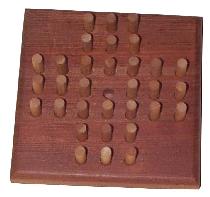
| Designer | : | Unknown |
| Craftsman | : | John Rausch |
| Category | : | Sequential Movement |
| Material | : | Mahogany |
| Pieces | : | 32, plus the board |
|
Though the origins of Peg Solitaire are unknown, John Beasley wrote in The Ins and Outs of Peg Solitaire in 1985 that there is evidence it existed as early as 1697 from an engraving by Claude-Auguste Berey and a description of it written by Leibnitz for the Berlin Academy in 1710. The earliest evidence I have comes from a personal experience while waiting for a fried chicken dinner at a local restaurant near Booneville, Kentucky in 1955. Most of the restaurants seem to have converted to the triangle version with golf tees for pegs.
The puzzle in the photograph was the first puzzle I ever made shortly after the restaurant encounter in 1955. It is known as the English Cross board and is the most common, at least historically. The triangle version seems to be the only one I see in the restaurants and gift shops these days. Probably because it's so much cheaper to make. The most common objective of the puzzle is to leave a single peg in the center hole by jumping and removing pegs. Other objectives can be to leave multiple pegs (with no jumps available) in symmetrical positions on the board. There are also hundreds of starting positions with various objectives. | ||